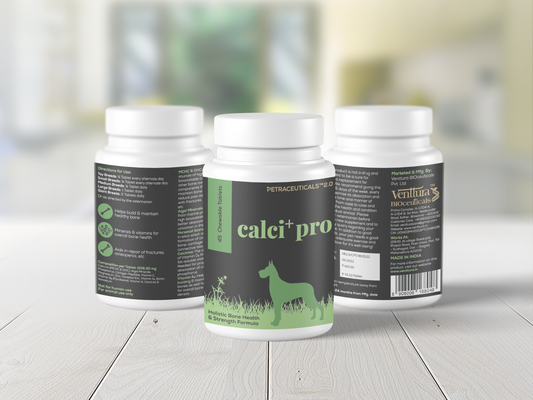Introduction
Osteoarthritis (OA) is a chronic inflammation caused by joint cartilage degeneration, leading to inflammation, stiffness, pain and reduced mobility [1]. Since OA has no cure, treatment focuses on symptom management through weight control, exercise moderation, physical therapy, nutritional supplements, and anti-inflammatory medications, primarily NSAIDs [2] [3] . While NSAIDs are the standard treatment, they may cause side effects such as gastrointestinal issues, damage to kidneys, or biochemical abnormalities. Though effective for pain and inflammation, NSAIDs do not prevent cartilage degeneration. This has led to the widespread use of joint supplements, particularly glucosamine and chondroitin, as a key component of OA management [3] [4]. Although beneficial when used appropriately, excessive supplementation can have adverse effects. While toxicity from joint supplements is rarely documented in veterinary literature, reported cases primarily involve serious health risks, including organ dysfunction, hepatotoxicity, and metabolic imbalances with prognosis varying from guarded to poor in advanced stages. This article examines the risks associated with glucosamine and chondroitin overuse in dogs, highlighting evidence from scientific research and case studies.
What Are Glucosamine and Chondroitin?
Glucosamine and chondroitin are naturally occurring compounds in cartilage, the connective tissue that cushions the joints. Glucosamine, an amino sugar, acts as a building block for glycosaminoglycans (GAGs) within the extracellular matrix of articular cartilage. While healthy chondrocytes can produce glucosamine, osteoarthritic cartilage has a diminished ability to do so. External supplementation of glucosamine has been found to stimulate chondrocytes to generate proteoglycans and collagen. Additionally, it supports collagen synthesis, offers mild anti-inflammatory benefits, and possesses antioxidant properties [2] [3].
Chondroitin sulfate (CS) is a key glycosaminoglycan found in cartilage's extracellular matrix. It has long been taken orally to treat OA in both people and animals. There is evidence that CS inhibits histamine-induced inflammation and stimulates the production of collagen and glycosaminoglycan [2]. In the joint, chondroitin works to reduce destructive enzymes. Through better cartilage water retention and increased synovial fluid viscosity, it enhances joint function and mobility [3].
The Consequences of Oversupplementation
Hepatotoxicity
Liver toxicity associated with glucosamine-containing supplements in humans is generally linked to long-term use at recommended doses rather than acute overdose. In contrast, cases of liver toxicity in dogs due to joint supplements have only been reported in instances of significant overdose [5]. According to data from the ASPCA Animal Poison Control Center (2008–2009), excessive intake of joint supplements has been associated with liver damage in dogs. A toxicology review documented 21 cases of hepatic injury following accidental ingestion, affecting dogs ranging from 1.5 to 16 years old and weighing between 2.7 and 49.8 kg. The affected dogs consumed between 20 and 240 chewable tablets, resulting in glucosamine, creatine, and dimethylsulfone doses varying from 183 to 6,667 mg/kg, 418 to 2,667 mg/kg, and 45 to 4,000 mg/kg, respectively. Symptoms such as vomiting, diarrhea, and lethargy emerged within 30 minutes to 48 hours. Liver enzyme elevations were noted, with serum alanine aminotransferase (ALT) surpassing 1,000 U/L in 14 cases (normal range: 14–151 U/L). One dog, which ingested an unspecified amount of joint supplements, exhibited symptoms such as vomiting, diarrhea, and loss of appetite, ultimately progressing to acute liver failure and multi-organ dysfunction. Despite undergoing 11 days of intensive care, euthanasia was performed. A postmortem examination uncovered extensive liver damage (centrilobular necrosis), along with severe pathological changes in the kidneys (acute tubular necrosis and vascular thrombosis), pancreas (necrosis), and heart (myocardial necrosis) [6]. Reports of hepatotoxicity associated with glucosamine-containing supplements in humans generally involve prolonged use at recommended doses rather than acute overdose. The primary clinical symptoms linked to suspected toxicity included vomiting, diarrhea, reduced appetite, and jaundice [7] [8] [9]. In most cases, discontinuation of the supplement led to the resolution of elevated hepatocellular enzymes. However, one patient progressed to chronic hepatitis, while another experienced fulminant liver failure, resulting in death [7].
Increased Urination and Potential Kidney Strain
Large doses of glucosamine can lead to increased urination and excessive thirst due to its renal excretion. This phenomenon, termed osmotic diuresis, may place additional stress on kidney function, particularly in aging or overweight dogs. A case study documented an 11-year-old Labrador Retriever that developed excessive thirst (polydipsia), urinary incontinence and frequent urination (polyuria) after its glucosamine intake was raised from 500 mg to 1,000 mg per day. These symptoms subsided when the dosage was reduced to 500 mg, indicating a potential association between high-dose glucosamine and elevated urine output. Given that glucosamine is primarily eliminated through the kidneys, it may function as an osmotic diuretic, leading to increased fluid loss. This raises concerns regarding the impact of excessive glucosamine consumption, particularly in older or overweight dogs already susceptible to metabolic complications [10].
Hypernatremia
Excessive intake of joint supplements can result in severe hypernatremia, a condition marked by dangerously elevated sodium levels in the blood. This imbalance can lead to dehydration, neurological issues such as disorientation and seizures, and, in extreme cases, life-threatening complications. In one instance, a 9-year-old Maltese mix was taken to a specialty hospital after consuming a high dose of joint supplements. The dog exhibited vomiting and seizures, and blood tests confirmed severe hypernatremia. Immediate treatment was aimed at rapidly reducing sodium levels to prevent further neurological damage. With intensive care, the dog stabilized and was discharged after three days. This case underscores the significant risks of joint supplement overdose and the necessity of monitoring sodium levels in affected dogs. The patient had ingested 40 Dasuquin chews, equating to 4,615 mg/kg of glucosamine hydrochloride and 1,923 mg/kg of sodium chondroitin sulfate [3].
Another reported case involved a 6-year-old neutered male Dachshund that developed hypernatremia after consuming excessive amounts of glucosamine, chondroitin sulfate, and MSM. If left untreated, elevated sodium levels can cause dehydration, cellular dysfunction, and severe systemic complications [11].
Hyperglycaemia and Insulin Resistance
Glucosamine, a common component in joint supplements, has been associated with elevated blood sugar levels and potential insulin resistance. While it is widely used for joint support, research suggests that excessive consumption may disrupt glucose metabolism, posing a risk for diabetic or predisposed dogs [3]. Studies indicate that glucosamine can contribute to insulin resistance and diabetes-like symptoms by interfering with glucose utilization in muscles through specific metabolic pathways. Additionally, it may impair insulin secretion in response to glucose, further increasing the likelihood of hyperglycemia [10]. In one case involving a 9-year-old Maltese mix, the dog developed high blood sugar levels, suggesting metabolic disruption due to glucosamine overdose. Treatment with insulin helped regulate blood glucose, and the dog recovered within three days, highlighting the importance of early detection and prompt intervention [3]. These findings raise concerns about the effects of excessive glucosamine intake on glucose regulation, especially in dogs susceptible to diabetes.
Neurological Complications
Excessive ingestion of joint supplements has been associated with severe neurological effects, including seizures. In one case, a 9-year-old Maltese mix consumed a high dose of joint supplements, resulting in vomiting and seizures, primarily due to severe hypernatremia. This condition can lead to brain swelling and neurological dysfunction [3]. Emergency treatment focused on rapidly reducing sodium levels to mitigate further brain damage. Hypernatremia caused by joint supplement toxicity can also trigger disorientation and abnormal behavior, and if left untreated, may escalate to seizures, coma, or even death [11]. This case highlights the critical importance of proper dosing to prevent neurological complications.
Multi-Organ Failure and Fatal Toxicity
Excessive supplementation of joint health products can result in severe multi-organ dysfunction in dogs. One study documented a case involving a 5-year-old spayed female Bernese Mountain Dog that ingested approximately 200 joint supplement tablets, consuming up to 2,173 mg/kg of glucosamine and 217 mg/kg of chondroitin sulfate. This led to symptoms such as vomiting and melena. Despite intensive medical intervention, the dog developed coagulopathy, peritonitis, pancreatitis, and acute kidney injury, ultimately necessitating euthanasia. Postmortem analysis revealed extensive organ damage, including pneumonia, myocardial necrosis, centrilobular hemorrhage, necrosis of the liver, acute tubular necrosis and vasculitis [5]. Another case study highlighted that an overdose of joint supplements can induce systemic complications affecting multiple organs. A 6-year-old Dachshund exhibited signs of liver dysfunction, blood clotting abnormalities, kidney impairment (azotemia), and thrombocytopenia following excessive consumption of joint supplements. While aggressive treatment resulted in survival, the case emphasized that excessive intake may cause widespread organ damage, potentially due to ingredient interactions, elevated sodium levels, or other toxic effects. These findings stress the importance of regulating supplement dosage to prevent potentially fatal consequences.
Potential exposure doses included 1,900 mg/kg of glucosamine, 750 mg/kg of chondroitin sulfate, and 870 mg/kg of MSM [11]. In one case, a 5-year-old Pug ingested approximately 100 joint supplement tablets, consuming 10,344 mg/kg of glucosamine, 4,310 mg/kg of MSM, and 5,172 mg/kg of sodium chondroitin sulfate. This led to severe toxicity, with symptoms such as vomiting and ataxia. The dog subsequently developed hypernatremia, hyperchloremia, hepatic failure, metabolic acidosis and coagulopathy, ultimately requiring euthanasia on day six. Postmortem examination revealed centrilobular hepatic necrosis, renal thrombosis, acute tubular necrosis and necrosis of the pancreas and myocardium, along with elevated manganese levels in the liver and kidneys [12]. These cases highlight the significant risks associated with excessive joint supplement consumption and emphasize the necessity of adhering to recommended dosages.
Safety Profile and Commonly Suggested Dosages
In an animal risk assessment, the oral LD50 of glucosamine hydrochloride was reported as 5,000 mg/kg BW, while the no observed adverse effect level (NOAEL) in dogs was 2,149 mg/kg BW [5] [13]. It was also reported that the oral LD50 of glucosamine is 8,000 mg/kg, with no observed adverse effects at 2,700 mg/kg for 12 months [14]. The oral LD50 for chondroitin in dogs has not been established, but in mice, it was reported as 10,000 mg/kg BW [5] [13]. Although no standardized dosing guidelines exist, some pet health blogs and manufacturer recommendations, suggest glucosamine dosages of 250–500 mg for dogs weighing 2.3–9 kg, 500 mg for 9–20 kg, 1,000 mg for 20–40 kg, and 1,500 mg for dogs over 40 kg. Similarly, chondroitin sulfate is often listed at 900 mg for dogs under 36 kg and 1,800 mg for those above this weight. While these values reflect common practice, they are not derived from controlled clinical studies and should be interpreted cautiously.
Conclusion: Balance is Key
While joint supplements like glucosamine and chondroitin are generally considered safe, excessive intake can lead to severe health complications, including liver damage, metabolic imbalances, and multiple organ dysfunction. Case studies and research highlight the risks of over-supplementation, reinforcing the importance of adhering to recommended dosages and monitoring for any adverse effects. A balanced approach is thus essential to supporting joint health without compromising overall well-being.
References
1. Kampa, N., Kaenkangploo, D., Jitpean, S., Srithunyarat, T., Seesupa, S., Hoisang, S., Yongvanit, K., Kamlangchai, P., Tuchpramuk, P., & Lascelles, B. D. X. (2023). Study of the effectiveness of glucosamine and chondroitin sulfate, marine based fatty acid compounds (PCSO-524 and EAB-277), and carprofen for the treatment of dogs with hip osteoarthritis: A prospective, block-randomized, double-blinded, placebo-controlled clinical trial. Frontiers in veterinary science, 10, 1033188. https://doi.org/10.3389/fvets.2023.1033188
2. Beale B. S. (2004). Use of nutraceuticals and chondroprotectants in osteoarthritic dogs and cats. The Veterinary clinics of North America. Small animal practice, 34(1), 271–viii. https://doi.org/10.1016/j.cvsm.2003.09.008
3. Bunnell NM and Weatherton L (2023) Case report: Treatment of joint supplement toxicity resulting in acidemia, hyperglycemia, electrolyte derangements, and multiple organ dysfunction. Front. Vet. Sci. 10:1141978. https://doi.org/10.3389/fvets.2023.1141978
4. Rychel, J. K. (2010). Diagnosis and Treatment of Osteoarthritis. Topics in Companion Animal Medicine, 25(1), 20–25. https://doi.org/10.1053/j.tcam.2009.10.005
5. Nobles, I. J., & Khan, S. (201bern. Multiorgan dysfunction syndrome secondary to joint supplement overdosage in a dog. The Canadian veterinary journal = La revue veterinaire canadienne, 56(4), 361–364. https://pubmed.ncbi.nlm.nih.gov/25829554/
6. Khan SA, McLean MK, Gwaltney-Brant S. Accidental overdosage of joint supplements in dogs. J Am Vet Med Assoc 2010;236:509–510. https://www.researchgate.net/publication/42594946_Accidental_overdosage_of_joint_supplements_in_dogs
7. Smith A, Dillon J. Acute liver injury associated with the use of herbal preparations containing glucosamine: Three case studies. BMJ Case Rep 2009; pii: bcr02.2009.1603. https://doi.org/10.1136/bcr.02.2009.1603
8. Cerda C, Bruguera M, Parés A. Hepatotoxicity associated with glucosamine and chondroitin sulfate in patients with chronic liver disease. World J Gastroenterol 2013;19:5381–5384 https://doi.org/10.3748/wjg.v19.i32.5381
9. Ebrahim V, Albeldawi M, Chiang DJ. Acute liver injury associated with glucosamine dietary supplement. BMJ Case Rep 2012;pii: bcr2012007665. https://doi.org/10.1136/bcr-2012-007665
10. McCoy, S. J., & Bryson, J. C. (2003). High-dose glucosamine associated with polyuria and polydipsia in a dog. Journal of the American Veterinary Medical Association, 222(4), 431–432 https://www.researchgate.net/publication/10891672_High-dose_glucosamine_associated_with_polyuria_and_polydipsia_in_a_dog_2
11. Weatherson, H. O., Bellis, T., & Tse, Y. (2021). The successful treatment of multiple organ dysfunction syndrome and severe hypernatremia, secondary to joint supplement toxicity in a dog. Journal of veterinary emergency and critical care (San Antonio, Tex. : 2001), 31(3), 432–438. https://doi.org/10.1111/vec.13033
12. Borchers, A., Epstein, S. E., Gindiciosi, B., Cartoceti, A., & Puschner, B. (2014). Acute enteral manganese intoxication with hepatic failure due to ingestion of a joint supplement overdose. Journal of veterinary diagnostic investigation : official publication of the American Association of Veterinary Laboratory Diagnosticians, Inc, 26(5), 658–663. https://doi.org/10.1177/1040638714544316
13. Hathcock, J. N., & Shao, A. (2007). Risk assessment for glucosamine and chondroitin sulfate. Regulatory toxicology and pharmacology : RTP, 47(1), 78–83. https://doi.org/10.1016/j.yrtph.2006.07.004
14. Shurlock, T. (n.d.). Joint supplements: Potential for harm. GWF Nutrition Limited. https://www.gwfnutrition.com/pages/knowledge-base-joint-supplements?srsltid=AfmBOoph2Hg7kW-ZT2eYIHM5lJic4V1NBAIxoN4aQ1SdvdR84NNeBy0X

 Proud to have impacted over 1 Million Happy Pet Parents since 2013.
Proud to have impacted over 1 Million Happy Pet Parents since 2013. 











